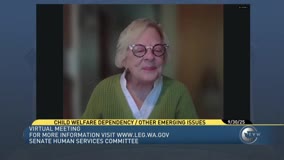Legal advocates and parent‑ally clinics urge prevention-first approach and more treatment, housing and parent‑support services
September 30, 2025 | Legislative Sessions, Washington
This article was created by AI summarizing key points discussed. AI makes mistakes, so for full details and context, please refer to the video of the full meeting. Please report any errors so we can fix them. Report an error »

Advocates with legal and lived‑experience perspectives told the Senate Human Services Committee that prevention‑forward, community‑centered supports reduce the chances that families will come into contact with the child‑welfare system and reduce critical incidents when opioid exposure is involved.
Annie Chung, director of legal services at Legal Counsel for Youth and Children (LCYC), described the goals behind the 2021 Keeping Families Together law and said LCYC supported the legislation because it raised the removal standard and focused on reducing disproportionality for Black and Native families. Chung told the committee LCYC has filed private dependency petitions when DCYF did not, and said their petitions challenging imminent physical harm have resulted in removal in every case LCYC filed, which, she said, indicates courts are able to apply the imminent‑harm standard where facts warrant it.
Clinic leaders described a prevention model built in partnership with medical providers. Adam Bailout, an attorney with the FIRST clinic (Family Intervention Response to Stop Trauma), said the clinic pairs a legal advocate with a parent ally who has lived experience, and that the clinic began in 2019 to intervene before CPS involvement. Bailout said the clinic now receives some screened‑out DCYF intakes as part of a pilot and works with hospitals to connect families to community resources. He reported that 83% of families the clinic serves keep their children with them and that 33% of those families had prior CPS involvement.
Parent ally Jennifer (last name withheld in testimony) described her own experience: a past dependency that resulted in termination of parental rights, followed by recovery and later successful engagement with a parent‑ally clinic. She told the committee that family‑inclusive programs, short‑term inpatient options that allow parent and child to enter treatment together, transportation, housing and parent‑led supports such as third‑party safety plans are critical. Jennifer said those supports, paired with respectful engagement, helped her regain stability and become a parent ally.
Speakers asked the committee to support expanded evidence‑based family‑inclusive treatment beds (both short inpatient and longer inpatient programs), more sites for Parent Child Assistance Program (PCAP, which serves families with infants), transportation and housing supports for parents leaving treatment, and funding for parent‑ally roles. Clinic leaders said parent‑ally involvement builds trust and increases the likelihood that families will engage with services without the threat of child removal.
The committee heard also that application of DCYF policy varies by county and office. Advocates said that “justice by geography” means similar families can experience different outcomes depending on the local DCYF office’s approach to voluntary placements, shelter‑care practices and transfers to treatment.
Less critical details: advocates described specific in‑community practices such as CPR and safe‑sleep training for parents and encouraged the committee to prioritize prevention resources so families are not first supported only after contacting the child‑welfare system.
Annie Chung, director of legal services at Legal Counsel for Youth and Children (LCYC), described the goals behind the 2021 Keeping Families Together law and said LCYC supported the legislation because it raised the removal standard and focused on reducing disproportionality for Black and Native families. Chung told the committee LCYC has filed private dependency petitions when DCYF did not, and said their petitions challenging imminent physical harm have resulted in removal in every case LCYC filed, which, she said, indicates courts are able to apply the imminent‑harm standard where facts warrant it.
Clinic leaders described a prevention model built in partnership with medical providers. Adam Bailout, an attorney with the FIRST clinic (Family Intervention Response to Stop Trauma), said the clinic pairs a legal advocate with a parent ally who has lived experience, and that the clinic began in 2019 to intervene before CPS involvement. Bailout said the clinic now receives some screened‑out DCYF intakes as part of a pilot and works with hospitals to connect families to community resources. He reported that 83% of families the clinic serves keep their children with them and that 33% of those families had prior CPS involvement.
Parent ally Jennifer (last name withheld in testimony) described her own experience: a past dependency that resulted in termination of parental rights, followed by recovery and later successful engagement with a parent‑ally clinic. She told the committee that family‑inclusive programs, short‑term inpatient options that allow parent and child to enter treatment together, transportation, housing and parent‑led supports such as third‑party safety plans are critical. Jennifer said those supports, paired with respectful engagement, helped her regain stability and become a parent ally.
Speakers asked the committee to support expanded evidence‑based family‑inclusive treatment beds (both short inpatient and longer inpatient programs), more sites for Parent Child Assistance Program (PCAP, which serves families with infants), transportation and housing supports for parents leaving treatment, and funding for parent‑ally roles. Clinic leaders said parent‑ally involvement builds trust and increases the likelihood that families will engage with services without the threat of child removal.
The committee heard also that application of DCYF policy varies by county and office. Advocates said that “justice by geography” means similar families can experience different outcomes depending on the local DCYF office’s approach to voluntary placements, shelter‑care practices and transfers to treatment.
Less critical details: advocates described specific in‑community practices such as CPR and safe‑sleep training for parents and encouraged the committee to prioritize prevention resources so families are not first supported only after contacting the child‑welfare system.
View full meeting
This article is based on a recent meeting—watch the full video and explore the complete transcript for deeper insights into the discussion.
View full meeting
